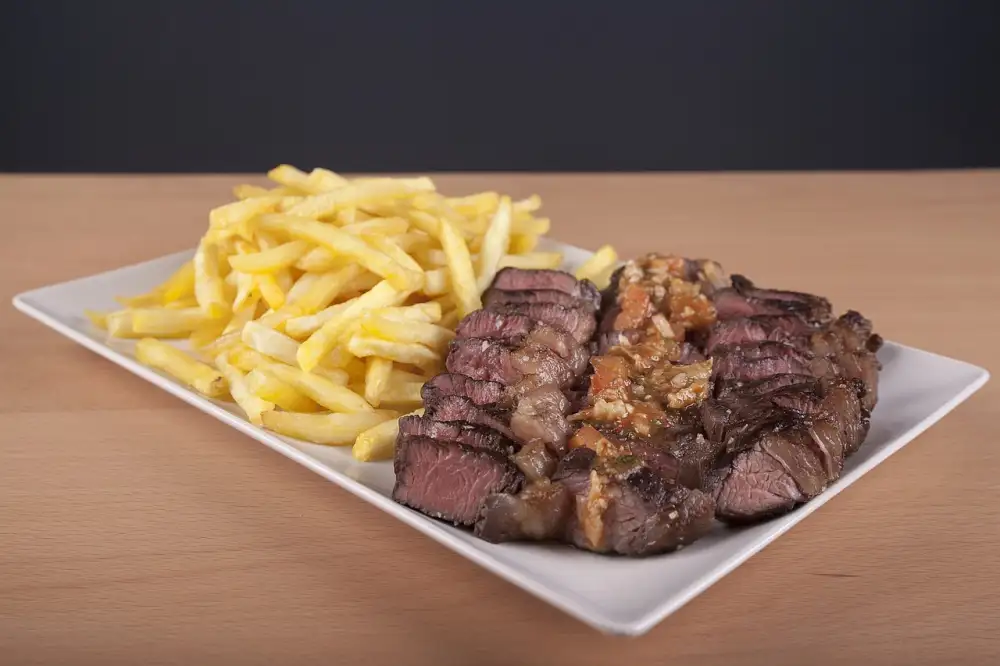Savory Delights: Exploring the Irresistible Flavors of Rump Steak

Rump steak, a succulent and flavorful cut of beef, is a favorite among meat lovers. Known for its rich taste and tender texture, rump steak is a versatile ingredient that can be prepared in various ways. Whether grilled, pan-fried, or slow-cooked, this delectable cut never fails to satisfy the palate. In this article, we will delve into the origins and history of rump steak, explore its characteristics and cuts, provide tips on selecting and cooking the best rump steak, share popular recipes and serving suggestions, discuss its health benefits, answer frequently asked questions, and ultimately celebrate the irresistible flavors of this culinary delight.
Origin and History of Rump Steak
Originating from the United Kingdom, rump steak has a rich history that dates back centuries. This cut of beef can be traced back to the 18th century, where it was commonly enjoyed by the British aristocracy. The term "rump" refers to the hindquarters of the animal, specifically the area above the tail and below the sirloin.
Rump steak gained popularity due to its robust flavor and tender texture. It was traditionally served as a prime cut in high-end restaurants and grand banquets. Over time, its popularity spread beyond Britain, making it a beloved choice among meat lovers worldwide.
In recent years, rump steak has become more accessible and affordable for everyday cooking. Its versatility in various cuisines has contributed to its widespread appeal. Whether grilled, pan-seared, or slow-cooked, rump steak continues to be cherished for its delectable taste and ability to elevate any dish it is used in.
Characteristics and Cuts of Rump Steak
Rump steak is a popular cut of beef known for its rich flavor and tender texture. It is taken from the hindquarters of the animal, specifically the top of the rump. This area is well-exercised, resulting in lean and flavorful meat.
The main characteristic of rump steak is its firm texture, which makes it ideal for grilling or pan-frying. The meat has a good amount of marbling, which adds to its juiciness and enhances the overall taste. Rump steak is also versatile and can be used in various dishes, from stir-fries to stews.
There are different cuts available within the rump steak category, each with its own unique qualities. The most common cuts include center-cut rump steak, also known as sirloin cap or picanha; top sirloin cap; and eye of round. These cuts vary in tenderness and can be prepared differently depending on personal preference.
Center-cut rump steak is highly prized for its tenderness and robust flavor. It has a thick layer of fat on one side, which helps keep the meat moist during cooking. Top sirloin cap is another popular choice, known for its intense beefy flavor and tender texture. Eye of round is leaner compared to other cuts but still offers a good amount of flavor when cooked properly.
When selecting rump steak, look for meat that is bright red in color with minimal discoloration or browning. The fat should be creamy white rather than yellowish. Opt for cuts that have fine marbling throughout as this indicates better flavor and tenderness.
Overall, rump steak offers a delicious combination of taste and texture that appeals to meat lovers around the world. Its versatility allows for endless culinary possibilities, making it an excellent choice for any occasion.
How to Select the Best Rump Steak
When it comes to selecting the best rump steak, there are a few key factors to consider. First and foremost, look for a steak that is bright red in color with marbling throughout. The marbling indicates the presence of fat, which adds flavor and tenderness to the meat.
Additionally, check for a steak that is firm to the touch. Avoid steaks that feel soft or mushy, as this could be a sign of poor quality or spoilage. The steak should also have a fresh, clean smell.
Another important consideration is the grade of the steak. In general, higher grades such as USDA Prime or Choice will offer superior taste and tenderness compared to lower grades. However, keep in mind that higher grades may also come with a higher price tag.
Lastly, pay attention to the thickness of the steak. Thicker cuts are generally preferred as they allow for better control over cooking temperatures and result in juicier meat.
By taking these factors into account, you can ensure that you select the best rump steak for your culinary adventures.
Tips for Preparing and Cooking Rump Steak
When it comes to preparing and cooking rump steak, there are a few tips that can help you achieve the perfect dish. Firstly, make sure to bring the steak to room temperature before cooking. This allows for even cooking throughout. Secondly, season the steak generously with salt and pepper or your favorite seasoning blend. This will enhance the flavors of the meat. Next, preheat your grill or pan to high heat to achieve a nice sear on the outside of the steak while keeping the inside juicy. Cook the steak for about 4-5 minutes per side for medium-rare or adjust according to your preferred level of doneness. Finally, let the cooked steak rest for a few minutes before slicing into it. This allows the juices to redistribute and ensures a tender and flavorful result. With these tips in mind, you'll be able to prepare and cook rump steak like a pro!
Popular Recipes and Serving Suggestions for Rump Steak
1. Classic Grilled Rump Steak: Marinate the steak with olive oil, garlic, salt, and pepper. Grill it over high heat for about 4-5 minutes per side for medium-rare doneness. Serve with a side of roasted vegetables or a fresh salad.
2. Pan-Seared Rump Steak with Mushroom Sauce: Season the steak with salt and pepper. Heat a skillet with butter and sear the steak for 3-4 minutes on each side. Remove the steak and set aside. In the same pan, sauté mushrooms until golden brown, then add beef broth and cream. Simmer until thickened and serve the sauce over the steak.
3. Rump Steak Stir-Fry: Slice the rump steak into thin strips. In a hot wok or skillet, stir-fry the beef with your choice of vegetables like bell peppers, onions, and broccoli. Add soy sauce, ginger, garlic, and a touch of honey for flavor. Serve over steamed rice or noodles.
4. Rump Steak Tacos: Season the steak with chili powder, cumin, garlic powder, salt, and pepper. Grill or pan-sear until desired doneness. Let it rest before slicing into thin strips. Fill warmed tortillas with the steak slices and top with salsa, guacamole, shredded cheese, and cilantro.
5. Rump Steak Salad: Grill or pan-sear the rump steak to medium-rare doneness. Let it rest before slicing thinly against the grain. Toss mixed greens with cherry tomatoes, cucumber slices, red onion rings, crumbled feta cheese, and your favorite dressing. Top with the sliced rump steak for a hearty salad.
These recipes showcase different ways to enjoy rump steak's rich flavor and tender texture in various dishes that can be customized to suit individual preferences.
Health Benefits of Consuming Rump Steak
Rump steak not only tantalizes our taste buds but also offers several health benefits. Here are some reasons why including rump steak in your diet can be beneficial:
1. High Protein Content: Rump steak is an excellent source of high-quality protein, which is essential for muscle growth and repair. It helps in maintaining healthy bones, skin, and hair.
2. Iron-Rich: Rump steak is a great source of iron, a mineral that plays a vital role in the production of red blood cells and oxygen transportation throughout the body. Consuming rump steak can help prevent iron deficiency anemia.
3. Vitamin B12: Rump steak is rich in vitamin B12, which is necessary for nerve function and the formation of red blood cells. Adequate intake of vitamin B12 from sources like rump steak can support brain health and boost energy levels.
4. Zinc: Rump steak contains zinc, an essential mineral that aids in immune system function, DNA synthesis, and wound healing. It also contributes to normal growth and development.
5. Omega-3 Fatty Acids: Although not as high as fatty fish, rump steak does contain some omega-3 fatty acids, which are known for their anti-inflammatory properties and potential cardiovascular benefits.
Remember to consume rump steak in moderation as part of a balanced diet to reap its nutritional benefits while considering individual dietary needs and preferences.
Frequently Asked Questions about Rump Steak
1. What is rump steak?
Rump steak is a cut of beef that comes from the hindquarters of the animal. It is known for its rich flavor and tenderness.
2. How should I store rump steak?
To ensure freshness, it is best to store rump steak in the refrigerator at a temperature below 40°F (4°C). Make sure to place it in an airtight container or wrap it tightly in plastic wrap.
3. Can I freeze rump steak?
Yes, you can freeze rump steak. Wrap it tightly in freezer-safe packaging and store it for up to six months. Thaw it in the refrigerator before cooking.
4. How do I know if rump steak is cooked properly?
The best way to determine if rump steak is cooked to your desired doneness is by using a meat thermometer. For medium-rare, the internal temperature should be around 130°F (54°C).
5. Can I marinate rump steak?
Absolutely! Marinating can enhance the flavor and tenderness of rump steak. You can use various marinades such as garlic, soy sauce, or red wine for a delicious result.
6. Is rump steak suitable for grilling?
Yes, rump steak is perfect for grilling due to its natural tenderness and flavor. However, make sure not to overcook it as it may become tough.
7. Are there any alternatives to rump steak?
If you're looking for alternatives with similar characteristics, you can try sirloin or ribeye steaks. They also offer great taste and tenderness.
8. Can I use rump steak in stir-fries or stews?
Certainly! Rump steak works well in stir-fries and stews as long as you slice it thinly against the grain for optimal tenderness.
Remember, experimenting with different cooking methods and flavors can help you discover the best way to enjoy rump steak.
In conclusion, rump steak is a true delight for food enthusiasts. Its rich flavor, tender texture, and versatility make it a favorite choice for many meat lovers. Whether grilled, pan-seared, or slow-cooked, rump steak never fails to impress with its irresistible taste. So next time you're craving a savory and satisfying meal, don't forget to indulge in the deliciousness of rump steak.
Published: 29. 11. 2023
Category: Food



